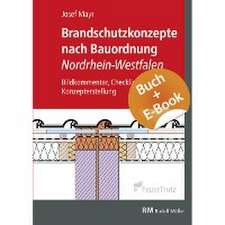Large-Eddy Simulation Based on the Lattice Boltzmann Method for Built Environment Problems
Autor Mengtao Han, Ryozo Ookaen Limba Engleză Paperback – 31 mai 2024
Toate formatele și edițiile
| Toate formatele și edițiile | Preț | Express |
|---|---|---|
| Paperback (1) | 879.21 lei 38-45 zile | |
| Springer Nature Singapore – 31 mai 2024 | 879.21 lei 38-45 zile | |
| Hardback (1) | 1109.92 lei 3-5 săpt. | |
| Springer Nature Singapore – 30 mai 2023 | 1109.92 lei 3-5 săpt. |
Preț: 879.21 lei
Preț vechi: 1156.85 lei
-24% Nou
Puncte Express: 1319
Preț estimativ în valută:
168.23€ • 175.65$ • 139.24£
168.23€ • 175.65$ • 139.24£
Carte tipărită la comandă
Livrare economică 31 martie-07 aprilie
Preluare comenzi: 021 569.72.76
Specificații
ISBN-13: 9789819912667
ISBN-10: 9819912660
Pagini: 216
Ilustrații: XX, 216 p. 87 illus., 5 illus. in color.
Dimensiuni: 155 x 235 mm
Ediția:2023
Editura: Springer Nature Singapore
Colecția Springer
Locul publicării:Singapore, Singapore
ISBN-10: 9819912660
Pagini: 216
Ilustrații: XX, 216 p. 87 illus., 5 illus. in color.
Dimensiuni: 155 x 235 mm
Ediția:2023
Editura: Springer Nature Singapore
Colecția Springer
Locul publicării:Singapore, Singapore
Cuprins
Part I Fundamental Theory of Lattice Boltzmann Method.- Chapter 1 Introduction.- Chapter 2 Fundamental theory of lattice Boltzmann method.- Chapter 3 Implementation of boundary conditions.- Chapter 4 From Lattice Boltzmann Equation to Fluid Governing Equations.- Chapter 5 LBM-based large-eddy simulation (LBM-LES).- Chapter 6 From LBE to LBM:Using LBM to solve problems.- Part II Practice of LBM-LES in Built Environment.- Chapter 7 LBM-LES in ideal lid-driven cavity flow problems.- Chapter 8 LBM-LES in isothermal indoor flow problems.- Chapter 9 LBM-LES in outdoor wind environment around a single building.- Appendix.
Notă biografică
Mengtao Han, Ph.D., is Associate Professor of the School of Architecture and Urban Planning, Huazhong University of Science and Technology, Wuhan, P. R. China. He has been an architect for several years in China and then obtained his Ph.D. from the Architecture Department at the University of Tokyo in 2019. He worked as a postdoctoral researcher at the Institute of Industrial Science, University of Tokyo, Japan, from 2019 to 2020. He also worked as a young scientists research fellow of the Japan Society for the Promotion of Science (JSPS) from 2018 to 2020. He is now working on developing and applying airflow simulation methods in the building environment and building energy-saving technologies.
In the last five years, he focused on developing and applying the lattice Boltzmann method to the built environment and made several achievements in this field. He has chaired two projects related to this field, published dozens of high-level research papers, and published a book as asecond author.
Prof. Ryozo Ooka received his B.E. and M.E. degrees in Faculty of Engineering from Kyoto University, Kyoto, Japan, in 1989 and 1991, respectively, and the Ph.D. degree in Architecture department from The University of Tokyo, Tokyo, Japan, in 1997. After earning his degree, Prof. Ooka served as an associate professor at Fukui University, Fukui, Japan, and then at the University of Tokyo, Tokyo, Japan. Since 2009, Prof. Ooka has been a professor at the Institute of Industrial Science, the University of Tokyo.
Prof. Ooka focuses on predicting and controlling the urban atmospheric environment. His recent research interests include: optimal design methods for urban energy systems, CFD application in and around Buildings, development of high-energy efficiency buildings, etc. Prof. Ooka has published over 400 peer-reviewed technical papers in international journals and conferences. He is the chair of the Sustainable Building Committee and Urban and Climate Change Committee from the Architectural Institute of Japan. He is also the president of IAQVEC (Indoor Air Quality, Ventilation, Energy Conservation in Buildings) Association and ASHRAE (American Society of Heating, Refrigeration, Air-conditioning Engineers) Japan Chapter. He was a recipient of the prize of Architectural Institute of Japan in 2015, and four best paper awards from the Society of Heating, Air-conditioning and Sanitary Engineering of Japan in 2009, 2012, 2017 and 2019. He is also SHAESE Fellow and ASHREA Fellow.
In the last five years, he focused on developing and applying the lattice Boltzmann method to the built environment and made several achievements in this field. He has chaired two projects related to this field, published dozens of high-level research papers, and published a book as asecond author.
Prof. Ryozo Ooka received his B.E. and M.E. degrees in Faculty of Engineering from Kyoto University, Kyoto, Japan, in 1989 and 1991, respectively, and the Ph.D. degree in Architecture department from The University of Tokyo, Tokyo, Japan, in 1997. After earning his degree, Prof. Ooka served as an associate professor at Fukui University, Fukui, Japan, and then at the University of Tokyo, Tokyo, Japan. Since 2009, Prof. Ooka has been a professor at the Institute of Industrial Science, the University of Tokyo.
Prof. Ooka focuses on predicting and controlling the urban atmospheric environment. His recent research interests include: optimal design methods for urban energy systems, CFD application in and around Buildings, development of high-energy efficiency buildings, etc. Prof. Ooka has published over 400 peer-reviewed technical papers in international journals and conferences. He is the chair of the Sustainable Building Committee and Urban and Climate Change Committee from the Architectural Institute of Japan. He is also the president of IAQVEC (Indoor Air Quality, Ventilation, Energy Conservation in Buildings) Association and ASHRAE (American Society of Heating, Refrigeration, Air-conditioning Engineers) Japan Chapter. He was a recipient of the prize of Architectural Institute of Japan in 2015, and four best paper awards from the Society of Heating, Air-conditioning and Sanitary Engineering of Japan in 2009, 2012, 2017 and 2019. He is also SHAESE Fellow and ASHREA Fellow.
Textul de pe ultima copertă
This book details the lattice Boltzmann method (LBM) applied to the built environment problems. It provides the fundamental theoretical knowledge and specific implementation methods of LBM from the engineering perspective of the built environment. It covers comprehensive issues of built environment with three detailed cases, solving practical problems. It can be used as a reference book for teachers, students, and engineering technicians to study LBM and conduct architecture and urban wind environments simulations, in the fields of architecture, building technology science, urban planning, HVAC, built environment engineering, and civil engineering.
Caracteristici
Provides detailed methods and precautions for lattice Boltzmann method to simulate building environment problems Covers fundamental but comprehensive issues of built environment with three detailed cases Provides systematic fundamentals of lattice Boltzmann methods from engineering practical perspective









